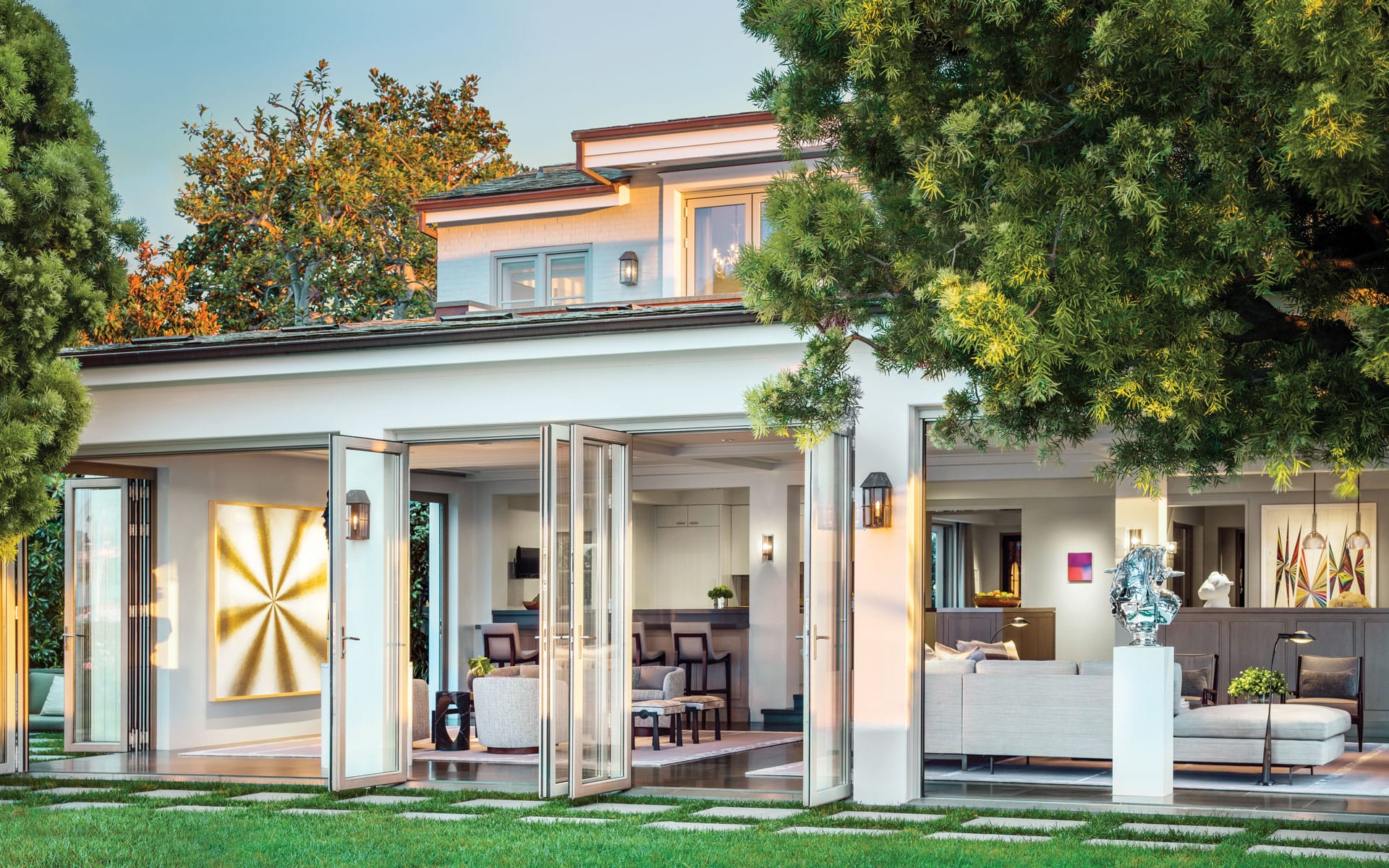A 1920s Newport Beach Home Gets Transformed for Contemporary Art Collectors
Designer James Magni reimagines the California residence by maximizing waterfront views and carving out space for attention-grabbing works

When Robert Beauchamp, the Los Angeles dentist who pioneered providing services on credit and founded Western Dental, moved his family to Newport Beach in the mid-1950s, their 1927 Cape Cod–style house was one of four dwellings on the tip of the Balboa Peninsula. “It was a free-for-all. Our school uniform was shorts, T-shirts, and sandals, and we were walking distance from the Wedge, the famous bodysurfing beach,” recalls David Beauchamp, the family’s youngest son, now 74. “Today when the waves are 25 feet tall, these TV and film crews come down to see the Wedge break, but that was our playground as kids and nobody else went there.”
In the mid-2000s David Beauchamp and his wife, Tracy, built a modernist teak-and-limestone beach house designed with James Magni in China Cove, just across Newport Bay from the peninsula. During the four years of construction, they moved into his childhood home—which had remained in the family after his parents died—and fell in love with it. “We enjoyed the boating aspect because there was a dock and we didn’t have that at China Cove,” says Beauchamp, whose career has spanned finance and real estate investment. “We became a part of the community.”


The couple liked it so much that after completing their China Cove residence, they decided to sell it, buy out his siblings’ shares in the Balboa Peninsula house, and make it their primary home. They engaged Magni’s firm, Magni Kalman Design, to undertake what they envisioned as a light remodel of the then five-bedroom property. In the end, they wound up doing a down-to-the-studs overhaul, bringing in EBTA Architects to restructure some interior spaces.

Among the changes they made was converting an upstairs sleeping porch once used by Beauchamp and his siblings into a guest room that also serves as an office and, most significant, combining the former lanai and a closed-off staff kitchen with the living area to create a dramatic, free-flowing great room wrapped in glass nano doors that open onto the bay. Early on, a contractor had encouraged the couple to level the house and rebuild to save time and money, but their sense of nostalgia prevailed. They even opted to have the 95-year-old edifice’s original slate roof and brick façade taken down, refurbished, and reinstalled. “Keeping the integrity of the house was very important to them,” says Jason Kalman.
Another challenge—and a blessing—notes Magni, “is that everywhere you look you see water. It’s all views. I always tell people we can’t compete with God, so let’s go subdued and allow the interior to flow.”

To enhance the sense of indoor-outdoor continuity, the designers matched the slate around the lap pool and entry walk with the floor tiles inside. They also installed cerused-white-oak casework and created custom furnishings throughout—from wool-and-silk rugs to ombré-finish Lucite tables, which are paired with vintage chairs by T. H. Robsjohn-Gibbings upholstered in a Magni Home Collection leather. Refined materials and textures were key for the furnishings, including the cast-aluminum dining chairs by DLV Designs and the Cedric Hartman bronze floor lamps in the great room. The walls and tray ceilings, meanwhile, were kept crisp and white to let the couple’s burgeoning art collection shine.

“They were collecting Laguna watercolors when I met them,” recalls Magni, who introduced the Beauchamps to art adviser Michael E. Thomas. The couple has since amassed some 90 works by blue-chip artists such as Kehinde Wiley, Takashi Murakami, Joyce Pensato, and Mark Grotjahn. “The kids have been educated to not touch the Tara Donovan pins,” Magni jokes, remarking that Beauchamp is hardly ever without wet feet and Tracy is always at the tennis courts across the street, now the Peninsula Point Racquet Club, which the family has all but donated to the community.


The couple, who rotate the works on view twice a year, want to ensure the house never feels like a museum. “We don’t live in a serious place—we live on the beach,” says Beauchamp. “So there’s also a sense of whimsy and playfulness to the art.” He points to the stairwell, where mirrored balloons by Jeppe Hein are suspended from the ceiling opposite an epic Garth Weiser abstraction. Joel Morrison’s stainless-steel sculpture The Decline of Western Civilization depicts the artist’s beloved studded jean jacket “sort of draped over a rock star’s bust with detailing that is like jewelry,” says Magni, who placed the work prominently in front of glass doors in the great room.

Another family favorite is Gavin Turk’s American Bag, a painted bronze sculpture replicating a bursting-at-the-seams trash bag that the pair cheekily installed by the front door. “All our friends try to pick it up and take it out to the curb,” says Beauchamp, laughing. Like the house, “it’s a serious piece of art,” he adds, “but playful.”
A version of this article first appeared in print in our 2022 Summer Issue under the headline “Going Home Again.” Subscribe to the magazine.























